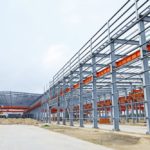Features - Business
Locally sourced: Why sustainable supply chains are key to cutting CO2 emissions

The UK government is expected to present a revised net-zero strategy ahead of 2023, which will put the construction industry in a very tricky position. The built environment contributes around 40% of the UK’s CO2 emissions (11% from the construction industry), setting the stage for intense scrutiny in the coming months.
In this article, Neeral Shah, founder and CEO of YardLink, explores the main steps the industry can take.
When it comes to our sector’s carbon footprint, no other role has the authority to be as decisive as main contractors. And there’s a very simple explanation for that – they’re the decision makers who ultimately deliver the build. With main contractors responsible for coordinating subcontractors and a wide range of resources, they are well situated to create real transformation in the construction sector.
The construction supply chain could be much more efficient, and now more than ever, there are huge risks – from a weak pound to energy bills – which impact every stage of a project and now more than ever, there are huge risks – from a weak pound to energy bills – which impact every stage of a project.
The good news is that the actionable steps main contractors can take to change our sector’s environmental impact are not only time-saving, and therefore cost-efficient, but can be straightforward. Here’s why:
It’s there for the taking
Construction firms tend to operate very traditionally and old habits die hard. But these conventional ways of doing business, such as relying on long-standing relationships with suppliers, can cost main contractors and projects precious time. Modernising the process of sourcing suppliers, however, can find new solutions to old problems.
Take large construction projects, for instance. These sites host between around 50 and 70 subcontractors, all of which use a range of materials and equipment to carry out different types of work. What’s interesting is that the disconnect between these subcontractors on-site is so substantial, that it often leads to significant wastage, and main contractors aren’t even aware.
As a simple example, a range of plant and tools might be rented by subcontractors from different suppliers miles apart from each other – all for the same project – generating multiple deliveries and collections for underutilised equipment. Sharing supply chain information, as well as equipment utilisation on site, between subcontractors could reduce the number of wasted journeys back and forth between rental depots.
This lack of visibility across resources on-site leads to subcontractors purchasing from their traditional suppliers, ignoring available equipment and materials more local to their projects.
A win-win
These are difficult times for the UK’s economy, and, with the cost of construction materials expected to continue rising, main contractors need to appeal to solutions that don’t break the bank.
Our sector’s current supply chain is highly fragmented, but the good news is that sourcing suppliers locally tackles not only the CO2 emissions construction generates, but unnecessary costs as well.
As it stands, on a typical large construction project there may be up to 100 vehicles delivering materials or equipment each week. Many of the suppliers delivering goods to site may carry overlapping inventory, and generally travel an average distance of up to 30 miles per journey. Based on data we have compiled from large projects in London, over 300 tonnes of CO2 is emitted from these delivery vehicles alone, a significant proportion of which could be eliminated by digitising and sharing information between subcontractors to consolidate their supply chains.
Simply put, if contractors and subcontractors changed the dynamics of their supply chain and adopted a local, digital and collaborative approach to sourcing, they would not only cut CO2 emissions, but tackle overspending on logistics as well. Main contractors certainly benefit from this, and so does the environment.
A connected supply chain
Countless contractors across the country will have to complete projects they agreed to deliver several months ago, despite inflation having reached its highest level in 40 years. So let’s be honest – the coming months will be challenging and costly.
On the other hand, our sector will be increasingly pressured to present realistic plans to reduce CO2 emissions. The time to actually make substantial changes in our conventional operations has finally arrived, and main contractors will be pushed into the spotlight.
The solution to both of these challenges lies beyond sharing resources on-site. It’s also about consolidating and sharing information, as well as improving communication between subcontractors on site. The right transformation will be the one that helps the environment and contractors alike thrive. In view of this, revamping our industry’s operations with locally sourced, sustainable supply chains will be crucial to achieving net-zero.
If you would like to read more stories like this, then please click here
Related Articles
More Features
- Ten years of progress on payment, pre-qualification and skills
19 May 25
The industry has made significant progress on late payment, pre-qualification, and competence since the formation
- Pagabo provides clarity on impacts of new NPPS and PPNs
12 Mar 25
The Labour government’s new National Procurement Policy Statement (NPPS) sets out strategic priorities for public
- How is the Procurement Act going to drive social value
24 Feb 25
The regulations laid out within the Procurement Act 2023 will go live today.






